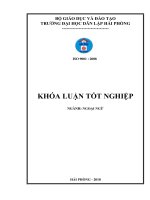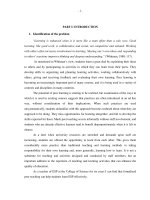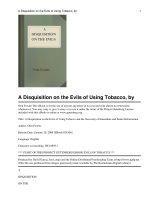A view on the art of academic reseach writing aug 2017
Bạn đang xem bản rút gọn của tài liệu. Xem và tải ngay bản đầy đủ của tài liệu tại đây (1.98 MB, 28 trang )
A View on the Art of Academic R
esearch Writing
ICS Takushoku University
Prof. Koji FUJIMOTO
Aug. 2017
1
Contents of Presentation
• A Thesis/Dissertation Must Consist of Two Papers
• Conceptual Framework of Thesis/Dissertation
• Conceptual Framework and A Japanese Proverb “When Win
d Blows, Barrel-Makers Earn More”
• Hints on How to Create Hypothesis
• Sample Thesis “Brantas River Basin Dev. Plan of Indonesia
(Brantas Plan)”
• Concerns Required in Writing Thesis/Dissertation
• Styles of Thesis/Dissertation
• Personal Experiences on which This View Relies
2
A Thesis/Dissertation Must Consist of Two P
apers
• A Theoretical Paper: Theoretical development has
to be hypothesized. (Theoretical Contribution)
For instance: Lewis Model → Ranis-Fei Model
• An Empirical Paper: The theoretical development
above has to be proved empirically with newly co
llected primary data. (Empirical Study)
For instance: Cobb-Douglas Production Function
Y = AKαL(1-α)
3
Conceptual Framework of Thesis/Dissertatio
n
• Hypothesis: A hypothesis, a theoretical developme
nt of existing theory or new theory, is to be formul
ated on a set of assumptions.
• Empirical Study: To analyze empirically the hypot
hesis utilizing primary data which are related to th
e assumptions to prove causality in the hypothesis.
• Empirically Proved Hypothesis: The causality of h
ypothesis is thus proved empirically. In other word
s, the dissertation is completed.
4
Conceptual Framework and A Japanese Proverb
“When Wind Blows, Barrel-Makers Earn More”
• Hypothesis: “When Wind Blows, Barrel-Makers Earn More”
Land of strong wind → Dusts whirl in the wind → More eye diseases →
More blind people → More masseurs (who play the Shamisen to get a
job) → Cats are killed for their skin→ Rats increase → Rats bite
barrels→ More job and more income of barrel-makers
• Assumptions: i. Windy/dusty country, ii. Wooden barrels commonly
used, iii. Barrel-maker is common occupation, iv. Rats and cats here
and there, v. The blind’s job is massage, vi. Masseurs use Shamisen
• Empirical Study: Primary/local data collection (field work) to
counter-check assumptions and to prove cause-and-effect relationship (Causality) between “wind-blow” and “barrel-maker’s income”
→ Thesis/Dissertation is completed
5
Hints on How to Create/Construct Hypothesi
s
• Accumulated knowledge and experience are essential
for hypothesis formulation.
• Pre-reading of many reference materials (academic pa
pers, books, etc.), experience-oriented observation, int
uition and the like need to be fully used and mobilize
d.
• Forefront issues of specialized fields/areas.
• Wide knowledge of related fields/areas are advantageo
us and often indispensable, such as shown in Figure 1
on next slide.
6
Figure 1 Grand Design of Development Studies
Development Studies/Dev. Cooperation Studies
DC
Advanced Cs
Bretton Woods
UN Agencies
DAC/CSO
Dev. Theory/
Growth Theory
Economic Dev.
ODA
Social Development
Development Finance
Project Devlopment
Peace and Security
Culture
Infra. Dev.
Poverty, Gender, Environment
Participatory Dev., Urban Dev.,
Development and Institution,
NGO
7
A Case of “Brantas River Basin Dev. Plan o
f Indonesia” (Brantas Plan)
• Description of Brantas Plan
This is the Integrated Development Plan for the Basin of Brantas
River which runs over 320 km covering 12,000 km 2 of the basin are
a in East Java, Indonesia.
Japanese Government helped to implement the Brantas Plan over 4
0 years (1959 through 2002). It formulated 4 Master Plans at interval
s of 10 years and provided Technical and Financial Assistance for 31
large scale infra-projects (9 multi-purpose dams, 6 barrages, 8 irrigat
ions, 6 river improvements and 2 volcanic Sabo-dams).
In financial terms, Japan assisted over \170 billion ODA (US$1.7 b
illion) out of total investment costs of \225 billion (US$2.25 billion)
8
Fujimoto, Koji (2013), ‘Brantas River Basin Development Plan of Indones
ia’, in M. Nissanke and Y. Shimomura (eds) Aid as Handmaiden for the De
velopment of Institutions –A New Comparative Perspective, pp161-94, Palgr
ave Macmillan
Brantas Plan
9
Brantas Plan
• Hypothesis: Economic infrastructure development can be
a product of an interaction between physical development
and institutional evolution.
» Special attention was paid to the performance gap
between Japan’s successful infra-ODA to Asian
countries and Europe’s unsuccessful infra-ODA to
African countries.
» Would there be “something different” that caused the
gap other than physical infra-structures constructed ?
» Would that be “Institution” as defined by Douglass
North ?
10
Brantas Plan
11
Brantas Plan
• Assumptions:
(i) Priority projects are selected in the Dev. Plan.
(ii) Foreign aided infra-projects are implemented in
accordance with international guidelines:
Consultant Employment, Procurement, Environment,
Gender and so forth.
(iii) Post evaluation of every project is carried out.
(iv) Institutions play an important role in project
performance throughout the project cycle (P/C).
12
Brantas Plan
• Empirical Study:
Related documents such as F/S reports, project appraisal
reports, post-evaluation reports are reviewed, and field
interviews are carried out.
» 4 M/Ps and 31 Infra-projects are reviewed and
“Activities and Products” at 3 stages (Planning stage,
Implementation stage, Post implementation stage) of
P/C are identified.
» Institutions are identified and reviewed over
evolutionary process from three aspects: Origin, Process
and Consolidated/Final Form.
» Impacts and contribution on “Activities and Products”
that institutions made are grasped.
13
Brantas Plan
Empirical Study in Brantas Plan
14
Brantas Plan
* Output & Outcome
Output: Physical facilities of 31 projects, and EIRR, p
addy yield, flood control, hydropower generation, etc.
Outcome: Human resource development, economic gr
owth, people’s mindset, poverty reduction, etc.
** Institutional Evolution (i) Long-term commitmen
t (over 40 years), (ii) ‘Master plan’ cum ‘project imple
mentation’ approach, (iii) Full-scale technology transf
er mechanism, (iv) Tri-party trust.
15
Brantas Plan
• Empirically Proved Hypothesis:
» The four Institutions (Long-term continuous
commitment, ‘Comprehensive master plan’
cum ‘project implementation’ approach, Full-scale
technology transfer mechanism and Tri-party trust)
clarified in the Empirical Study, namely the Cause,
are concluded to have contributed to upgrading
increasingly “Activities and Products” of each
stage of P/C as time went on, namely the Effect.
(Causality)
16
Concerns Required in Writing Thesis/Dissert
ation
(1) Thesis/Dissertation goes through the process of
fermentation. Issues/problems confronted during thesis
writing are settled through fermentation process.
(2) Articulate use of terminology is “Must”. Technical
terminology must be used uniformly with clear
definition throughout.
(3) Frequent editing is necessary and sufficient condition
for quality thesis/dissertation writing.
(4) Use of subject “I” is not allowed in academic T/D
writing. The passive voice, or “They” “We” “One” are
widely accepted and used.
17
Styles of Thesis/Dissertation
(1)Style Guide in Thesis/Dissertation Writing:
Two Representative Books
(i) Turabian, Kate L. A Manual for Writers of
Research Papers, Theses, and Dissertations, 8th
ed. Chicago: University of Chicago Press, 2013
(ii) MLA. MLA Handbook for Writers of Research
Papers, 7th ed. Modern Language Association
of America, March 2009
18
Style
19
Style
(2) Style Guide of Takushoku University for
Thesis/Dissertation Writing
» ICS Takuhsoku University (2014), Style Guide
for Writers of Theses and Dissertations, a booklet
prepared for degree thesis/dissertation writers of
Takushoku University
» This booklet of Takushoku Univ. Style guide is
largely based on Chicago Manual Kate L.
Turabian), yet Takushoku Univ. local rules are
partly applied as needed
20
Style
21
Personal Experiences on which This View
Relies
(1) The First Academic Thesis Prof. Fujimoto Wrote is M. Phil. Degree Thesis
at University of York, U.K.
» Thesis title and degree year: Business Taxation and Export
Performance through Price Changes, and the M. Phil.
degree was conferred in 1975.
» Without having learnt on how to write thesis or referring to
style guide like Chicago Manual, this thesis was completed by
making most use of theses/dissertations of former graduate students
at York University.
» A fresh surprise at the level of the M.Phil. Thesis in terms of its
contents as well as style, when it is read today.
» This experience laid the foundation for Prof. Fujimoto’s research
activities today, a quarter century later.
22
Personal Experiences
23
Personal Experiences
(2) “A Thesis/Dissertation Must Consist of Two Papers,”
“Conceptual Framework,” “When Wind Blows, BarrelMakers Earn More”
» “A Thesis/…… Consist of Two Papers” has long been the
Prof. Fujimoto’s belief, which had never been taught at York
University. Yet, he learned it through encounters with
academic staff and colleague students at York.
» “Conceptual Framework”, the same.
» “When Wind …… Earn More” occurred suddenly to Prof.
Fujimoto after several years of gestation period to find out a
practical way to explain how to write thesis/dissertation. (A
case of “ … through the process of fermentation.”)
24
Personal Experiences
(3) Theory and Assumptions
» Theories of social science are usually created,
through theorization and generalization, upon a set of
selected assumptions (economic and social phenomena)
which are observed influential and reasonable to them.
» Therefore, theories can be upgraded, evolved or
developed by improving and/or reducing assumptions.
» The first thing to be done at the higher/specialized
level of education (university level) is to teach “how the
theory is structured and created” !!
25









